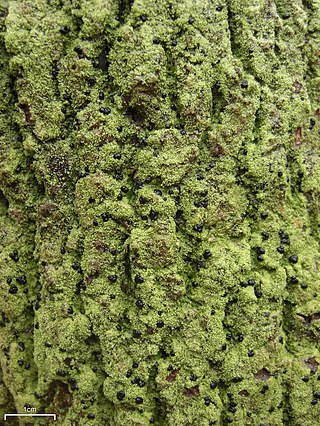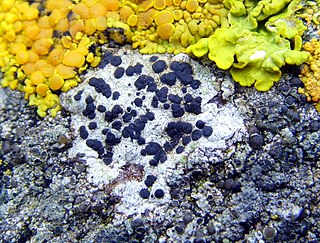
The Lecanoraceae are a family of lichenized fungi in the order Lecanorales. Species of this family have a widespread distribution.

Bacidia is a genus of lichen-forming fungi in the family Ramalinaceae. The genus was circumscribed by Giuseppe De Notaris in 1846. Species in the genus are crust-like lichens with stemless apothecia; they have green algae (chloroccoid) as photobionts. Their asci have 8 colorless, cylindrical to acicular, multiseptate spores, with curved and thread-like conidia.

Pilophorus is a genus of lichenized fungi in the family Cladoniaceae. They are commonly known as matchstick lichens. The genus has a widespread distribution, especially in temperate regions, and contains 11 species.

Diplotomma is a genus of lichenized fungi in the family Caliciaceae. The genus has a widespread distribution and contains about 29 species. The genus was circumscribed by Julius von Flotow in 1849. It was later wrapped into Buellia before being segregated from that genus by David Hawksworth in 1980.

Carbonea is a genus of fungi in the family Lecanoraceae. Most of the species grow on lichens. The genus is widespread, and contains 20 species. Carbonea was originally circumscribed as a subgenus of Lecidea in 1967 before it was promoted to generic status in 1983.

Lecidella is a genus of crustose lichens in the family Lecanoraceae.

Miriquidica is a genus of lichen in the family Lecanoraceae. The genus was circumscribed in 19876 by lichenologists Hannes Hertel and Gerhard Rambold, with Miriquidica complanata assigned as the type species. According to Dictionary of the Fungi, the widespread genus contains 23 species, found predominantly in arctic-alpine regions.

The Lecideaceae are a family of lichens in the order Lecideales.
Poeltiaria is a genus of lichen-forming fungi in the family Lecideaceae. It was circumscribed in 1984 by lichenologist Hannes Hertel, with Poeltiaria turgescens assigned as the type species.
Xenolecia is a genus of saxicolous (rock-dwelling) and crustose lichens in the family Lecideaceae. It has two species: X. cataractarum, and the type species, X. spadicomma. The genus was circumscribed by German lichenologist Hannes Hertel in 1987 to contain the type, a lichen known at that time only from the type locality on Wellington Island, Chile. Its range has since been expanded to include the Falkland Islands and northern Patagonia. X. cataractarum, found in Campbell Island, New Zealand was added to the genus in 2017.

Rhizocarpon is a genus of crustose, saxicolous, lecideoid lichens in the family Rhizocarpaceae. The genus is common in arctic-alpine environments, but also occurs throughout temperate, subtropical, and even tropical regions. They are commonly known as map lichens because of the prothallus forming border-like bands between colonies in some species, like the common map lichen.

Fuscidea is a genus of crustose lichens in the family Fuscideaceae. It has about 40 species. The genus was circumscribed in 1972 by lichenologists Volkmar Wirth and Antonín Vězda, with Fuscidea aggregatilis assigned as the type species.

Bryoria is a genus of lichenized fungi in the family Parmeliaceae. Many members of this genus are known as horsehair lichens. The genus has a widespread distribution, especially in boreal and cool temperate areas.

Catillaria is a genus of crustose lichens in the family Catillariaceae. The genus was circumscribed by Italian lichenologist Abramo Bartolommeo Massalongo in 1852. It is the type genus of Catillariaceae, which was circumscribed by Austrian lichenologist Josef Hafellner in 1984.

Hymenelia is a genus of lichen-forming fungi belonging to the family Hymeneliaceae.
Porpidia seakensis is a species of crustose lichen in the family Lecideaceae. It is an endolithic species, meaning it grows inside the rocks, between the grains. Found only in Alaska, it was formally described as a new species in 2020 by British lichenologist Alan Fryday. The type specimen was collected in the Hoonah-Angoon Census Area, in Glacier Bay National Park. Here it was discovered growing on granitic rock in a woodland. The lichen is only known from this area, although it is locally common. Its preferred habitat is siliceous rocks and boulders in wooded areas that are open and well lit. The specific epithet seakensis uses the letters "seak" to refer to a standard abbreviation for southeast Alaska.
Hannes Hertel is a German botanist and taxonomist and was Director of the State Herbarium in Munich, Germany 1992 - 2004. His specialist areas are the fungi and lichens.
Porpidia submelinodes is a species of saxicolous (rock-dwelling), crustose lichen in the family Lecideaceae. Found in the South Shetland Islands of Antarctica, it was formally described as a new species in 2011 by lichenologists Piotr Osyczka and Maria Olech. The type specimen was collected from Penguin Island, where it was found growing on a volcanic boulder. The lichen has a rusty orange thallus comprising distinct rounded areoles surrounded by deep cracks, and an inconspicuous black prothallus. It has soralia that are black with a whitish rim. All examined specimens were sterile, producing neither apothecia nor pycnidia. All chemical spot tests are negative, and the species does not contain any lichen products detectable with thin-layer chromatography. The species epithet refers to its similarity with Porpidia melinodes.














